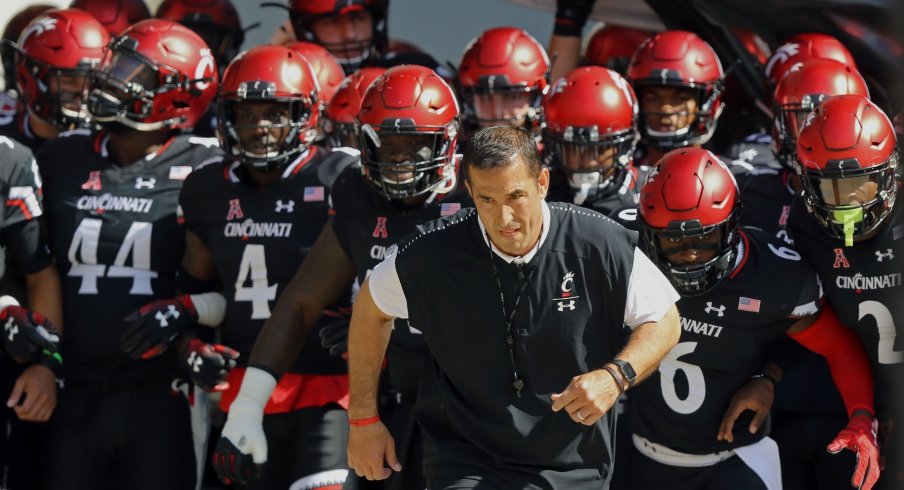By all measures, the University of Cincinnati football program peaked 10 years ago.
With Brian Kelly at the helm, who built upon a foundation started by Mark Dantonio, the Bearcats won back-to-back Big East titles in 2008 and 2009, reaching the Orange and Sugar Bowls while losing just two regular season games in as many seasons. Kelly's successor, Butch Jones, quickly rebounded after an initial 4-8 campaign in 2010 to post a pair of 10-win seasons himself before bolting to Tennessee.
Not since Sid Gillman led the program in 1951 had UC won ten games in a season and all of a sudden they did so four times in the matter of five years. But Tommy Tuberville couldn't continue the momentum through conference realignment, and the Bearcats went 4-8 in 2016, his last of four years in charge.
Luke Fickell needs no introduction among Buckeye fans. Years of service under a pair of title-winning bosses could have made him the heir-apparent in Columbus. But after 15 years as an assistant, the former Ohio State captain made the trek down I-71 to take his turn as a true head coach, able to lead a program as he desires.
In just two years, Fickell seems to have already left his mark. After a tough 4-8 first season in 2017, UC went 11-2 last fall. Their only losses came in a close, turnover-filled, defensive slugfest with Temple and during a November trip to Orlando in which they were outplayed by conference champion UCF in front of the College Gameday crew on national TV.
Though the latter left many thinking the Bearcats still weren't ready for primetime, all other indicators point the other way, as Fickell and one of his former pupils have quickly assembled one of the nation's best defenses. Cincinnati ranked ninth nationally in total defense last fall, allowing just 303 yards-per-game, while the advanced stats liked them even more, ranking sixth in rushing marginal efficiency and first in completion rate allowed.
Now, after never getting the chance to even interview for the head role at his alma mater, Fickell will get the chance to show Gene Smith and 105,000 or so spectators what they passed on during a week-two matchup in the Horseshoe. Though many Buckeye fans have decried the 2019 schedule as being without any signature out-of-conference opponents, this in-state clash has all the makings of a potential 'trap' game on September 7th.
The Bearcats began their 2018 campaign by holding Chip Kelly's UCLA offense to just 350 yards during a to the Rose Bowl and followed it up by stifling nearly the entire American Athletic Conference. Even in their 38-13 loss to UCF, the Knights were held to a regular-season low 402 yards, as three Bearcat turnovers tipped the game toward the home favorites.
While Fickell certainly played a major role in this defensive revival, former Buckeye linebacker and captain Marcus Freeman is in charge of the unit on a daily basis. After spending six seasons working for another former Buckeye assistant, Darrell Hazell, Freeman was given his first shot as a coordinator by his former position coach.
Today, despite both players learning the ropes in strict 4-3 systems, the Bearcats would best be described as 'Multiple' under Freeman and Fickell. Lining up with two big tackles inside, a stout strong-side end and a standup, hybrid Jack linebacker, UC can seamlessly switch between odd and even fronts from play-to-play.
Despite a lack of recruiting stars, this group was the bedrock of the entire team last fall. Seniors Kimoni Fitz, Cortez Broughton, and Marquise Copeland combined for 152 tackles in 2018, a total which, by comparison, was only last matched by a trio of D-linemen in Columbus in 2015 when Tyquan Lewis, Joey Bosa, and Adolphus Washington tallied 154.
Fickell and Freeman cycled through a deep rotation up front, allowing their wrecking crew to not only stay fresh but give valuable experience to younger players. When the seniors were in the game, however, they were incredibly disruptive (as seen from Copeland #44 below).
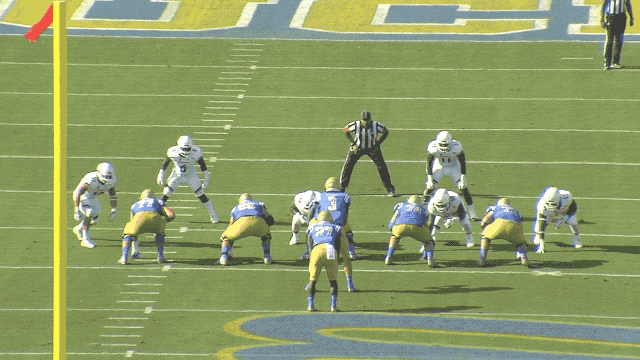
But the Bearcat front wasn't just a group of wild penetrators, as they proved quite capable of occupying blocks to allow their linebackers the freedom to track the ball. As seen below, both tackles force double-teams while inside linebackers Byran Wright (#11) and Jarell White (#8) use those space-eaters like shields while they maintain inside and outside leverage (respectively) on the back in this outside zone run.
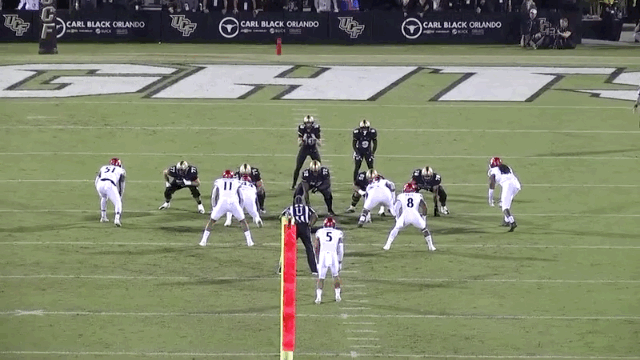
As one might expect from Fickell and Freeman, given their time in Columbus, the Bearcat linebacking crew got better throughout the 2018 season and may be the core of the unit this fall. Though they lost leading tackler Malik Clements, who lined up in a hybrid position over the slot (which the Bearcats call a Sniper), Wright and White both return and are versatile enough to stay on the field as the Bearcats rotate between 4-3, 4-2-5, and 3-3-5 looks.
Behind them, Freeman employs a great deal of man-coverage, though he does so somewhat conservatively. Instead of pressing his defenders on the line and blanketing receivers at the snap, Freeman's DBs often give a cushion and play what's known as Banjo coverage.
In this technique, the defenders read their receivers in a true man-to-man style, only looking up and communicating with one another if they cross, prompting a switch like a pick-and-roll on the basketball court. By staggering their depth against receivers in twins and trips sets, the Bearcats can avoid pick plays that use aggressive, man-coverage against itself.
The secondary should be another position of strength as all four starters return. Corners Cam Jefferies and Coby Bryant will look to lock down the edges while safeties James Wiggins and Darrick Forrest man the safety spots.
Jefferies, in particular, can cause problems all over the field, showing an ability to break on the ball like a corner and let Freeman play man-coverage against spread looks from his base, 4-3 personnel.

When opponents got to third down, however, Freeman really turned up the heat, bringing a barrage of blitzes in the hopes of overwhelming his opponent. The strategy often worked, as the Bearcats surrendered a third-down conversion on just 28.35% of attempts last fall, the fifth-best rate in the nation.
Instead of simply bringing pressure with man-coverage behind it, Freeman mixed in some zone and match coverages, providing a cloudy picture to the quarterback by splitting the field with a different coverage to each side (a la TCU). Up front, UC would similarly mix things up, feigning pressure from one player while another comes on a delayed blitz.
Though the Buckeyes should be favored in this early-season contest, the Bearcats have all the tools necessary to cause serious trouble for an offense breaking in a new QB and four starters on the line. Luckily, Ryan Day and his staff were provided with a few clues for how to break down the UC defense, courtesy of UCF.
Like Day, Scott Frost apprenticed under Kelly as an assistant, and though the teacher struggled to get his offense going when facing Fickell and Freeman's defense, Frost's former charges in Orlando had his system humming with talented QB McKenzie Milton under center. Like Ohio State, the Knights look to use formations, motions, and options to keep defenses off-balance, and although the Bearcats kept it close for a half, eventually the Knights found their groove.
One particularly successful tactic was the use of a quick tempo. Throughout the game, the Bearcats seemed slow to line up, often allowing even bigger cushions than normal and sitting flat-footed while Milton threw quick-hitting passes after rushing to the line.
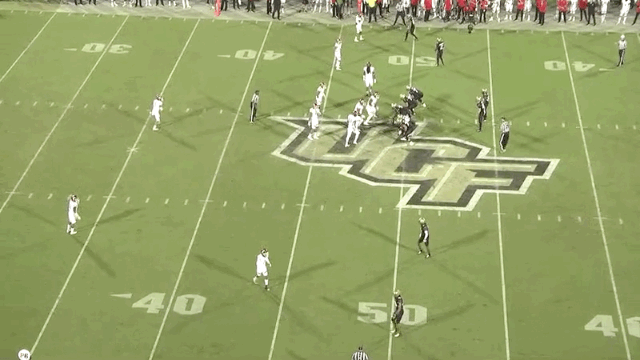
While Freeman's aggressive play-calls might scare many opponents into more conservative strategies, the Knights weren't afraid to match, looking to win one-on-one matchups in the secondary and bet on their all-conference quarterback to make plays.
While the Bearcat secondary seemed to have mastered the art of avoiding rub concepts, thanks to their Banjo coverage, the same couldn't be said of their linebackers. Matched up in solo coverage against speedy running back Adrian Killins Jr., the Knights were able to create roadblocks for the already disadvantaged Bearcat LBs by pairing backfield routes with those of a receiver outside.
By starting in an empty set and motioning Killins into the backfield, Milton had a clear read of the Bearcats' man-coverage. This allowed him to patiently wait for the wheel route to come open after a snag route from the wide receiver slowed down White (#8) as he desperately attempted to stay with the back downfield.
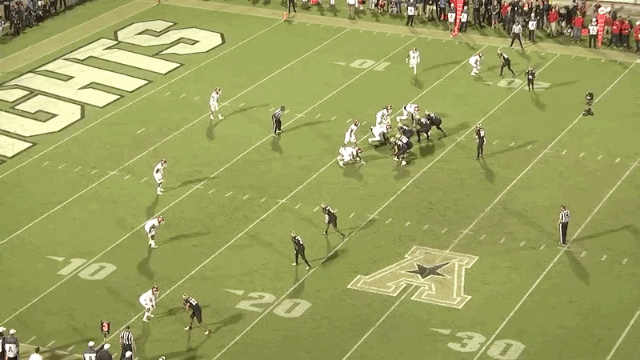
Similar opportunities arose in the screen game. The Knights used crack blocks from outside receivers to not only drag the cornerback inside on a man-coverage assignment but to take out the inside linebacker as well.
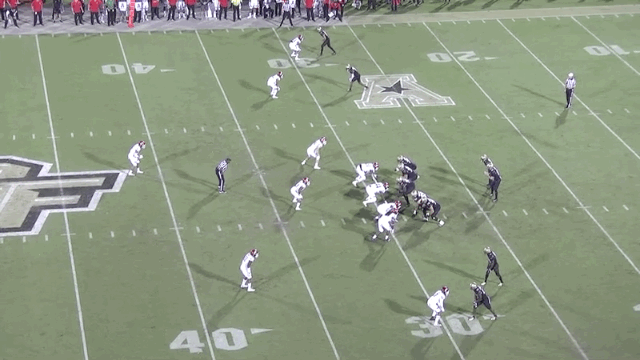
As Justin Fields will be making only his second start in a Buckeye uniform when the Bearcats come to town, creating mismatches like these with running backs J.K. Dobbins or Demario McCall may be an easy way to allow the new QB to gain comfort in his new surroundings. The strategy is quite similar, in fact, to the one that allowed Dwayne Haskins to lead a comeback in Happy Valley last season after struggling early on against an aggressive Penn State defense.
The Buckeyes may find an additional boost when reviewing the tape from week one. Kelly will bring his much-improved Bruins east to the Queen City to take on the Bearcats, providing Day with a first-hand account of what to expect should he call his former mentor.
But make no mistake, though Cincinnati may not be a Power-5 program, they will provide Ohio State with an important early season test. Luke Fickell brought the Bearcats to a national stage in only his second year on campus, and so far, he's built a defense to stay there.
